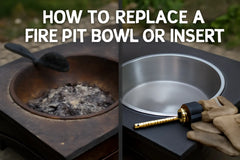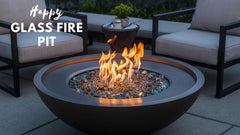Smokeless Fire Pits: How Do They Work and Are They Worth It?
Gathering around a fire pit is one of the simplest joys of outdoor living. The crackle of wood, the warmth on a cool evening, and the glow of flames make patios and backyards more inviting. Yet, there’s one major drawback: smoke.
Traditional fire pits often leave you smelling like campfire, cause watery eyes, and irritate your lungs. That’s where smokeless fire pits step in, promising the same cozy atmosphere without the unpleasant haze. But how do they work, and are they really worth the investment?
The Problem With Traditional Fire Pits
A standard fire pit burns wood in an open setting. When the wood doesn’t get enough oxygen, it smolders instead of burning cleanly. This incomplete combustion releases smoke, which contains tiny particles of carbon and other pollutants. The result is constant shifting around the pit to escape the smoke trail and lingering odors on clothes and furniture.
What Makes a Fire Pit Smokeless?
A smokeless fire pit doesn’t mean it produces zero smoke. Instead, it’s designed to minimize visible smoke through efficient combustion. These fire pits use a combination of clever airflow engineering and high temperatures to burn off wood gases before they escape. The result is a much cleaner burn with little to no smoke in the air.
How Smokeless Fire Pits Work
The secret lies in dual-burn technology. A smokeless fire pit is typically built with two walls and strategically placed air vents. Here’s the process:
-
Primary Combustion Wood is ignited at the bottom like any fire pit. Air enters through bottom vents to fuel the flames.
-
Secondary Combustion As the fire heats, air between the double walls rises and exits through vents near the top. This preheated air mixes with smoke particles and unburned gases, igniting them before they escape.
-
Hotter Flame Because of better oxygen flow, the fire burns hotter, cleaner, and more efficiently, resulting in far less smoke.
Types of Smokeless Fire Pits
There are different designs, but most fall into two categories:
-
Portable stainless-steel pits Lightweight, easy to move, and popular for camping or small patios.
-
Built-in stone or steel pits Larger, permanent installations for backyard entertaining.
Both work on the same airflow principle, but size and materials affect performance and cost.
Fuel Options for Smokeless Fire Pits
Most smokeless fire pits are designed for wood logs or wood pellets. Some models also accept charcoal, making them versatile for grilling. Wood pellets are especially efficient because they burn evenly and produce very little ash. Hardwoods like oak and hickory also perform better than softwoods, as they burn longer and cleaner.
Benefits of Smokeless Fire Pits
1. Less Smoke Irritation
The main advantage is comfort. No more red eyes, coughing fits, or constantly dodging the wind.
2. Cleaner Experience
Clothes, hair, and furniture don’t absorb smoke odors. Even after hours around the fire, you won’t smell like a campfire.
3. More Heat Output
Smokeless fire pits burn hotter because of improved airflow. This means you get more warmth from the same amount of wood.
4. Eco-Friendly Combustion
Since smoke is essentially wasted fuel, cleaner burning means fewer pollutants and better efficiency.
5. Less Ash Cleanup
Efficient burning reduces the amount of ash left behind, making cleanup quicker and easier.
Downsides of Smokeless Fire Pits
While the benefits are appealing, there are trade-offs:
-
Higher Cost Smokeless fire pits are more expensive than basic models, often ranging from $200 to $500 for portable versions.
-
Heavier Build Stainless-steel designs can be bulky, making them less convenient for frequent transport.
-
Hotter Surfaces Because of their efficient burn, the walls get extremely hot, requiring extra caution.
-
Limited Size Options Some models may not suit large gatherings, as they have smaller fire chambers than traditional pits.
Are They Really Smokeless?
No fire pit is completely smokeless. You may still see light smoke during startup or when adding damp wood. However, once the fire is established, the smoke reduction is dramatic compared to an open fire. With dry, seasoned wood, the experience is nearly smoke-free.
Cost Breakdown
The upfront cost is higher, but many users find it worthwhile for the comfort and efficiency. Here’s a rough estimate:
-
Portable smokeless fire pits: $200–$500
-
Built-in smokeless designs: $800–$2,000+
-
Wood pellets or hardwood logs: $10–$20 per bag or bundle
Compared to propane fire pits, which require ongoing fuel tank refills, wood remains a relatively affordable and accessible option.
Are Smokeless Fire Pits Worth It?
For families and outdoor enthusiasts who regularly enjoy fire pits, the answer is often yes. The reduced smoke makes gatherings more pleasant and eliminates the hassle of lingering odors. They’re also more efficient, so you may use less wood over time. However, for casual users who only light a fire a few times a year, a traditional fire pit may still be the more budget-friendly choice.
Best Situations to Use a Smokeless Fire Pit
-
Backyard entertaining keeps guests comfortable without smoke clouds.
-
Camping trips Portable models create a cleaner fire at campsites.
-
Cooking outdoors hotter flames make them great for roasting or grilling.
-
Urban patios Ideal for spaces where neighbors may be sensitive to smoke.
Final Thoughts
Smokeless fire pits combine modern engineering with timeless tradition. By improving airflow and combustion, they transform the outdoor fire experience into something cleaner, hotter, and more enjoyable. While they do come at a higher cost, for many homeowners and campers, the comfort and convenience justify the investment.
If you love gathering around a fire but dislike the smoke, a smokeless fire pit could be the perfect upgrade for your outdoor space.






